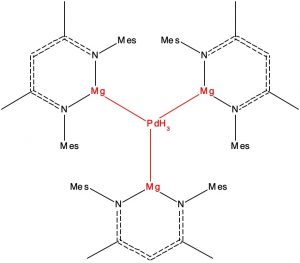
Here is another selection from the Molecules-of-the-Year shortlist published by C&E News, in which hexagonal planar transition metal coordination is identified.

Here is another selection from the Molecules-of-the-Year shortlist published by C&E News, in which hexagonal planar transition metal coordination is identified.
AbstractA heterobimetallic PtPd3 complex supported by three bridging diphenylsilylene ligands, [Pt{Pd(dmpe)}3(μ3‐SiPh2)3] (1, dmpe=1,2‐bis(dimethylphosphino)ethane), has been synthesized from mononuclear Pd and Pt complexes. The hexagonal core composed of Pt, Pd, and Si atoms is slightly larger than that of the tetrapalladium complex, [Pd{Pd(dmpe)}3(μ3‐SiPh2)3] (2). Reaction of PhSiH3 with complex 1 in the presence and absence of Ph2SiH2 results in the formation of a tetranuclear complex with silyl and hydride ligands at the Pt center, [PtH(SiPh2H){Pd(dmpe)}3(μ3‐SiHPh)3] (3), and an octanuclear complex, [{Pt{Pd(dmpe)}3(μ3‐SiHPh)3}2(κ2‐dmpe)] (5), respectively. Both M−Si (M=Pt, Pd) bond lengths and the 29Si NMR chemical shifts of 1 and 2 are located between those of mononuclear late transition‐metal complexes with a silylene ligand and complexes with donor‐stabilized silylene ligands. CuI and AgI adducts of 1 and 2, formulated as [M(μ‐M′I){Pd(dmpe)}3(μ3‐SiPh2)3] (M=Pt, Pd; M′=Cu, Ag), undergo elimination of CuI (AgI) and regenerate the tetrametallic complexes upon heating or addition of a chelating diphosphine. Elimination of AgI from 2‐AgI occurs more rapidly than elimination of CuI from 2‐CuI, as determined from the results of kinetics experiments.
AbstractBei der Reduktion von tBuAsCl2 mit Magnesium in Gegenwart von NiCl2 oder PdCl2 werden die Komplexe [Ni(tBuAs)6] (2) und [Pd(tBuAs)6] (3) gebildet. Die Struktur von (2) wurde durch Einkristall‐Röntgenstrukturanalyse bestimmt. (2) besteht aus dem (tBuAs)6‐Sechsring mit Sesselkonformation, in dessen Zentrum das Nickelatom koordiniert ist.